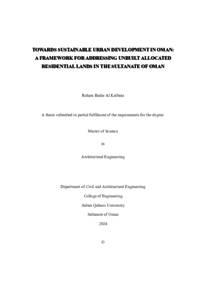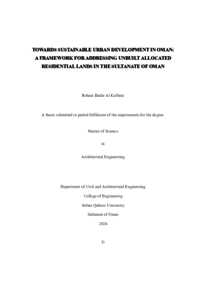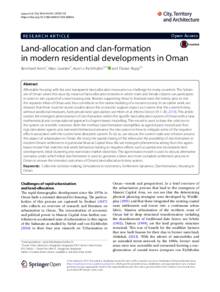Document
Towards sustainable urban development in Oman : a framework for addressing unbuilt allocated residential lands in the Sultanate of Oman
Source
Master's thesis
Country
Oman
City
Muscat
Publisher
Sultan Qaboos University.
Gregorian
2024
Language
English
Thesis Type
Master's thesis
English abstract
Housing is crucial for meeting basic human needs and rights, influencing environmental, transportation, and economic development. The right to adequate housing, recognised in the 1948 Universal Declaration of Human Rights, is consistently emphasized in international agreements and integral to the UN's 2030 Sustainable Development Goals. It has been the responsibility of each country to ensure the implementation of these rights for its citizens, regardless of its economic, political, or social context. Housing policy have undergone several transformations, with nations employing various approaches to fulfil this right. In Oman, rapid economic and population growth has brought about significant changes in urban and residential landscapes, presenting development opportunities but also highlighting challenges in housing and urbanization. Since the 1970s, population growth has increased housing demand, making residential land allocation an important aspect to urban development. Despite government efforts, a significant portion of allocated lands remains undeveloped, leading to unsustainable urban sprawl, increased infrastructure costs, landscape alterations, and substantial energy consumption. While the government aims for sustainable development through policy amendments, urban unsustainability and sprawl persist, necessitating a comprehensive approach to identify key factors preventing residential land development in Oman. The aim of this study is to address the problem of underdeveloped allocated residential lands in Oman by developing an assessment framework to identify factors hindering citizens from building, measuring key barriers, and providing insights for informed decision-making to promote urban sustainability in Oman. The study used a mixed-method approach, including a literature review and key document analysis to understand current land allocation process in Oman. A thorough literature analysis, to establish a framework for examining factors influencing the development of allocated residential land in Oman. This framework was validated with local stakeholders through a pile sorting workshop. The refined framework, comprising 17 indicators across 6 factors, ensuring contextual relevance in assessing unbuilt residential land. After that a questionnaire was then utilised based on the established framework to examine citizens' perception on the factors hindering the development of allocated residential land using a Likert scale and a snowball sampling approach. Statistical analysis was used to analyse the data obtained from the questionnaire, including descriptive, inferential, and Principal Components Analysis using SPSS software, that enhanced the study's depth, providing a comprehensive understanding of the dataset. Key findings highlighted the importance of factors including financial considerations, regulatory constraints, and services and infrastructure as significant impediments. Inferential statistics revealed notable patterns, with respondents who had been allocated residential land expressing higher concerns about services and facilities. Gender differences were observed, with males considering services and infrastructure more significant impediments. The principal component analysis further refined the factors influencing the development of allocated residential land, highlighting six main factors: Services and Infrastructure, Environmental and Geographical considerations, Financial aspects, Location preferences, Residential plans, and Land restrictions. This outcome provided a tailored framework for addressing the challenges of unbuilt allocated residential lands. This research provides valuable insights into sustainable urban development in Oman, offering a comprehensive framework and identified factors that can guide policymakers and urban planners. As Oman continues to urbanise and expand, the findings of this thesis provide an opportunity for future research and initiatives targeted at supporting sustainable urban development.
Arabic abstract
يعد السكن أمرا بالغ الأهمية لتلبية احتياجات الإنسان وحقوقه الأساسية، والتأثير على البيئة والنقل والتنمية الاقتصادية في الحق في السكن اللائق المعترف به في الإعلان العالمي لحقوق الإنسان لعام 1948، يتم التأكيد عليه باستمرار في الاتفاقيات الدولية وهو جزء لا يتجزأ من أهداف الأمم المتحدة للتنمية المستدامة لعام 2030 حيث تقع على عاتق كل دولة مسؤولية ضمان تنفيذ هذه الحقوق لمواطنيها، بغض النظر عن سياقها الاقتصادي أو السياسي أو الاجتماعي لقد شهدت سياسات الإسكان العديد من التحولات حيث تستخدم الدول أساليب مختلفة لتحقيق هذا الهدف.
في سلطنة عمان، أدى النمو الاقتصادي والسكاني السريع إلى إحداث تغييرات كبيرة في المشهد الحضري والسكني، مما يوفر فرصا للتنمية، ولكنه يسلط الضوء أيضا على التحديات في مجال الإسكان والتوسع الحضري منذ سبعينيات القرن العشرين أدى النمو السكاني إلى زيادة الطلب على الإسكان، مما جعل تخصيص الأراضي السكنية جانبا مهما للتنمية الحضرية على الرغم من الجهود التي تبذلها الحكومة، لا يرال جزء كبير من الأراضي المخصصة غير معمرة، مما يؤدي إلى زحف حصري غير مستدام، وزيادة تكاليف البنية التحتية، وتغيرات في طبيعة المنطقة، واستهلاك عالي للطاقة في حين تهدف الحكومة إلى تحقيق التنمية المستدامة من خلال التحسينات في السياسات الحالية، فإن عدم الاستدامة الحضرية والزحف العمراني لا يزالان قائمين، مما يستلزم اتباع نهج شامل لتحديد العوامل الرئيسية التي تحد من تعمير الأراضي السكنية المخصصة في سلطنة عمان.
تهدف هذه الدراسة إلى تناول مشكلة الأراضي السكنية المخصصة غير المعمرة في سلطنة عمان من خلال وضع إطار تقييم لتحديد العوامل التي تحد المواطنين عن البناء، وقياس العوائق الرئيسية، وتقديم رؤى لاتخاذ قرارات مستنيرة لتعزيز الاستدامة الحصرية في عمان .
استخدمت الدراسة منهجا مختلطا بما في ذلك مراجعة للأدبيات وتحليل الوثائق الرئيسية لفهم عملية تخصيص الأراضي الحالية في عمان كما شملت تحليل شامل للأدبيات، لإنشاء إطار الدراسة العوامل المؤثرة على تعمير الأراضي السكنية المخصصة في عمان. تم التحقق من صحة هذا الإطار مع الفئات المعنية المحليين من خلال ورشة قرر البطاقات تم بعد ذلك استخدام استبانة بناء على الإطار المحدد لفحص وجهة نظر المواطنين حول العوامل التي تعيق تطوير الأراضي السكنية المخصصة باستخدام مقياس ليكرت ومنهج أخذ العينات بطريقة كرة الثلج بعد ذلك، تم استخدام التحليل الإحصائي لتحليل البيانات التي تم الحصول عليها، بما في ذلك التحليل الوصفي والاستنتاجي وتحليل المكونات الرئيسية (PCA) باستخدام برنامج SPSS، مما عزز عمق الدراسة لتوفير فهم شامل لمجموعة البيانات .
من خلال ورشة قرر الأكوام، تم التركيز على العوامل الرئيسية مثل العوامل المالية، والعوامل الاجتماعية والمجتمعية، والخطط المستقبلية، والعوامل التنظيمية، وعامل الخدمات والبنية التحتية، والعوامل البيئية يتكون الإطار النهائي من 17 مؤشرا خلال 6 عوامل، مما يضمن ملاءمة السياق عند تقييم مشكلة الأراضي السكنية غير المعمرة .
أما الهدف الثاني فقد ركز على فهم العوامل التي تمنع المواطنين من البناء على الأراضي السكنية المخصصة لهم أبورت النتائج الرئيسية أهمية العوامل بما في ذلك العوامل المالية، والقيود التنظيمية، والخدمات والبنية التحتية باعتبارها عوائق مهمة في حين كشفت الإحصاءات الاستدلالية عن أنماط ملحوظة، حيث أبدى المشاركون الذين تم تخصيص أراضي سكنية لهم مخاوف أكبر بشأن الخدمات والمرافق ولوحظت فروق بين الجنسين، حيث اعتبر الذكور أن الخدمات والبنية التحتية تمثل عوائق أكثر أهمية قام تحليل المكون الرئيسي (PCA) بتحسين هيكلية العوامل التي تؤثر على تطوير الأراضي السكنية المخصصة مع تسليط الضوء على سنة عوامل رئيسية الخدمات والبنية التحتية، والاعتبارات البيئية والجغرافية، والجوانب المالية، وتفصيلات الموقع، والخطط السكنية، والقيود على الأراضي وقد وفرت هذه النتائج إطارا مخصصا لمواجهة تحديات الأراضي السكنية المخصصة غير المعمرة .
يقدم هذا البحث رؤى قيمة حول التنمية الحصرية المستدامة في عمان، ويقدم إطارا شاملاً وعوامل محددة يمكن أن توجه صناع القرار والمخططين الحضريين مع استمرار عمان في التوسع الحضري، فإن نتائج هذه الأطروحة توفر فرصة للبحوث والمبادرات المستقبلية التي تستهدف دعم التنمية الحضرية المستدامة.
في سلطنة عمان، أدى النمو الاقتصادي والسكاني السريع إلى إحداث تغييرات كبيرة في المشهد الحضري والسكني، مما يوفر فرصا للتنمية، ولكنه يسلط الضوء أيضا على التحديات في مجال الإسكان والتوسع الحضري منذ سبعينيات القرن العشرين أدى النمو السكاني إلى زيادة الطلب على الإسكان، مما جعل تخصيص الأراضي السكنية جانبا مهما للتنمية الحضرية على الرغم من الجهود التي تبذلها الحكومة، لا يرال جزء كبير من الأراضي المخصصة غير معمرة، مما يؤدي إلى زحف حصري غير مستدام، وزيادة تكاليف البنية التحتية، وتغيرات في طبيعة المنطقة، واستهلاك عالي للطاقة في حين تهدف الحكومة إلى تحقيق التنمية المستدامة من خلال التحسينات في السياسات الحالية، فإن عدم الاستدامة الحضرية والزحف العمراني لا يزالان قائمين، مما يستلزم اتباع نهج شامل لتحديد العوامل الرئيسية التي تحد من تعمير الأراضي السكنية المخصصة في سلطنة عمان.
تهدف هذه الدراسة إلى تناول مشكلة الأراضي السكنية المخصصة غير المعمرة في سلطنة عمان من خلال وضع إطار تقييم لتحديد العوامل التي تحد المواطنين عن البناء، وقياس العوائق الرئيسية، وتقديم رؤى لاتخاذ قرارات مستنيرة لتعزيز الاستدامة الحصرية في عمان .
استخدمت الدراسة منهجا مختلطا بما في ذلك مراجعة للأدبيات وتحليل الوثائق الرئيسية لفهم عملية تخصيص الأراضي الحالية في عمان كما شملت تحليل شامل للأدبيات، لإنشاء إطار الدراسة العوامل المؤثرة على تعمير الأراضي السكنية المخصصة في عمان. تم التحقق من صحة هذا الإطار مع الفئات المعنية المحليين من خلال ورشة قرر البطاقات تم بعد ذلك استخدام استبانة بناء على الإطار المحدد لفحص وجهة نظر المواطنين حول العوامل التي تعيق تطوير الأراضي السكنية المخصصة باستخدام مقياس ليكرت ومنهج أخذ العينات بطريقة كرة الثلج بعد ذلك، تم استخدام التحليل الإحصائي لتحليل البيانات التي تم الحصول عليها، بما في ذلك التحليل الوصفي والاستنتاجي وتحليل المكونات الرئيسية (PCA) باستخدام برنامج SPSS، مما عزز عمق الدراسة لتوفير فهم شامل لمجموعة البيانات .
من خلال ورشة قرر الأكوام، تم التركيز على العوامل الرئيسية مثل العوامل المالية، والعوامل الاجتماعية والمجتمعية، والخطط المستقبلية، والعوامل التنظيمية، وعامل الخدمات والبنية التحتية، والعوامل البيئية يتكون الإطار النهائي من 17 مؤشرا خلال 6 عوامل، مما يضمن ملاءمة السياق عند تقييم مشكلة الأراضي السكنية غير المعمرة .
أما الهدف الثاني فقد ركز على فهم العوامل التي تمنع المواطنين من البناء على الأراضي السكنية المخصصة لهم أبورت النتائج الرئيسية أهمية العوامل بما في ذلك العوامل المالية، والقيود التنظيمية، والخدمات والبنية التحتية باعتبارها عوائق مهمة في حين كشفت الإحصاءات الاستدلالية عن أنماط ملحوظة، حيث أبدى المشاركون الذين تم تخصيص أراضي سكنية لهم مخاوف أكبر بشأن الخدمات والمرافق ولوحظت فروق بين الجنسين، حيث اعتبر الذكور أن الخدمات والبنية التحتية تمثل عوائق أكثر أهمية قام تحليل المكون الرئيسي (PCA) بتحسين هيكلية العوامل التي تؤثر على تطوير الأراضي السكنية المخصصة مع تسليط الضوء على سنة عوامل رئيسية الخدمات والبنية التحتية، والاعتبارات البيئية والجغرافية، والجوانب المالية، وتفصيلات الموقع، والخطط السكنية، والقيود على الأراضي وقد وفرت هذه النتائج إطارا مخصصا لمواجهة تحديات الأراضي السكنية المخصصة غير المعمرة .
يقدم هذا البحث رؤى قيمة حول التنمية الحصرية المستدامة في عمان، ويقدم إطارا شاملاً وعوامل محددة يمكن أن توجه صناع القرار والمخططين الحضريين مع استمرار عمان في التوسع الحضري، فإن نتائج هذه الأطروحة توفر فرصة للبحوث والمبادرات المستقبلية التي تستهدف دعم التنمية الحضرية المستدامة.
Category
Theses and Dissertations



